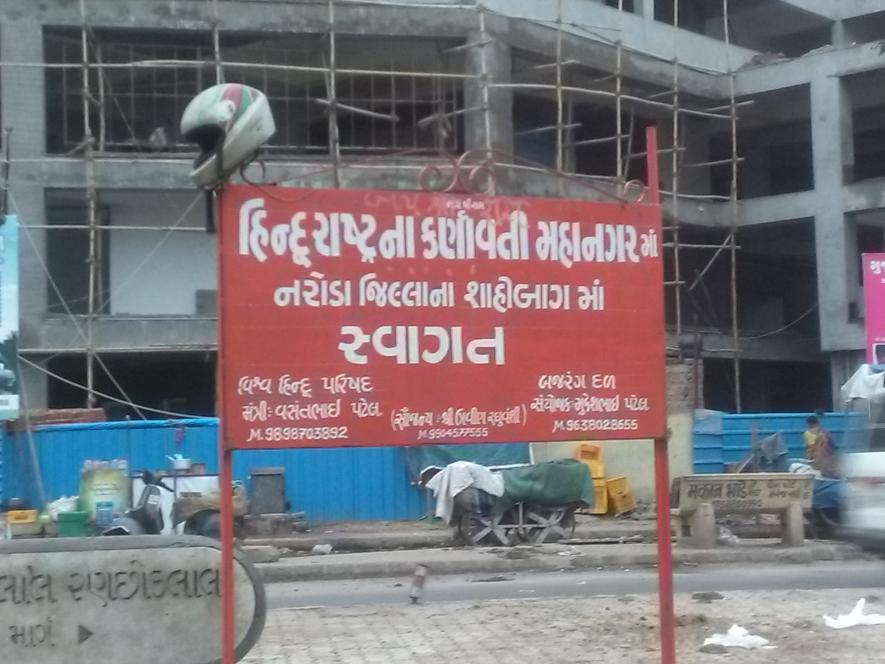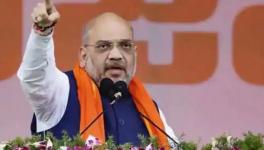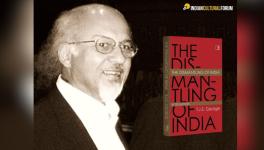Gujarat: Fact-Finding Report Says Riots Have Shifted to Rural Areas
Boards of "Welcome to Hindu Rashtra" in various places in Gujarat all signed by Bajrang Dal or VHP
Vadavali, a small village in Chanasma tehsil, Patan district, went up in smoke on March 26, 2017 after a communal riot razed it, leaving two dead, 25 injured and several homes gutted and looted. The family of Hussainbhai Rahimwala Sheikh was among the Muslims who fled their home which was burnt to ashes. The family, who had survived the riots in 2002, had settled in Vadavali as it was peaceful and had never heard of any communal tension.
Vadavali is not the only village in Gujarat which has witnessed communal riots or clashes in the last few years. In 2019 alone, there were six incidents of communal clashes or riots in various rural areas or small towns in Gujarat which had been unaffected by the 2002 riots.
According to a study by Buniyaad, a Gujarat-based minority rights organisation, the theatre for communal riots in the state has changed from urban to rural areas. Earlier, major cities like Ahmedabad, Surat and Vadodara had witnessed major communal riots in 1946, 1969,1981-82, 1985, 1990, 1992, 2002 and 2006. However, post-2002, places like Chattral in Gandhinagar district, Vadavali in Patan, Khambhat in Anand, Idar in Sabarkantha and Halvad in Morbi have been witnessing communal violence.
“In 2019, there were six incidents of communal violence in Gujarat out which five incidents took place in small towns, blocks and villages like Khambat in Anand, Kota Gadi in Sabarkantha, Nandoliya in Kadi Taluka, Dhunadra in Kheda district,” Hozefa Ujjaini, a Gujarat-based minority rights activist who was part of the fact-finding team, told NewsClick.
“There is another pattern to these incidents of communal violence. They are now happening at places which were unaffected by the riots of 2002,” Ujjaini added.
Notably, Khambhat, a coastal town in Anand district in central Gujarat, has emerged as a hot spot for communal tension since 2002. As per Buniyaad, in February 2012, a dispute over the construction of shops on land under the Waqf Board in Khambhat ended up in large-scale riots. The mobs used acid bulbs, petrol bombs, stones and torched six homes.
In November 2016, a minor incident of a Muslim autorickshaw driver colliding with the motorcycle of a person from the Ravar community in Pith Bazar area turned into a riot. The riots, which began with members of both communities pelting stones at each other, spread to neighbouring areas of Rana Chakla, Madai and Vasdavad in Khambat. Five houses belonging to Muslims, a temple, a Masjid, a Dargah and six shops – five owned by Muslims and one by a Hindu – were burned down. Four persons were severely injured in the clash as were three police personnel. In the years 2017 and 2018 Khambhat saw sporadic incidents of communal tension. Subsequently, the state government imposed the Disturbed Areas Act in the town that bars sale of property between two religious communities without prior permission from district authorities.
However, that did not stop incidents of communal clashes in Khambhat. In February 2019, a petty feud between two children over flying kites in Akbarpura area turned into a communal riot. The police fired seven rounds in the air and lobbed tear-gas shells to restore order. One police personnel was injured in the violence. In the same month, a small-scale communal incident occured over a social media post about the Pulwama attack in another part of Khambhat. In February 2020, Bhavsarwad, a Hindu-dominated area, was looted, following which an Anand-based right-wing outfit called Hindu Jagran Manch organised a rally and raised provocative slogans, urging Hindus to oust Muslims from the town. Sanjay Patel, BJP leader from Khambhat and a former MLA and Pinakin Brahmbhatt, the city unit head of the BJP, were among those who raised provocative religious slogans.
A few days after that rally, riots broke out in Khambhat, leaving around thirteen people injured while more than 30 shops, ten houses and several vehicles were torched to ashes. It took local police and the RAF about two hours to quell the mob. Seven FIRs were registered following the riots in which Patel and Brahmbhatt were named alongside several leaders of the Hindu Jagran Manch and a few local councillors.
“The deep roots of extreme right-wing outfits can be traced in this riot in Khambhat. There has been a surge of local Hindu supremacist outfits in small towns across the state. Almost in every incident of communal tension that has happened post 2002, the role of a newly-formed local right-wing outfit has been found. For instance, an outfit named Shri Ram Sena, formed about three or four years old and based in Khambhat, is constantly engaged in spreading hate speech and a distorted version of history on social media. They played a role in communalising a social media post on the Pulwama attack that resulted in riots in 2019,” said Ujjaini. “Another role these new right-wing outfits play is spreading propaganda like Love Jihad,” he added.
Out of the six riots in Gujarat in 2019, two were caused over ‘Love Jihad’.
In Mehsana, a Muslim boy and Hindu girl students of a local college were confronted by Dhaval Barot, a local VHP member, who accused the boy of ‘Love Jihad’. Barot threatened the couple but some college boys thrashed him instead. Later, Barot told local media and wrote on social media that he was a victim who was protecting a Hindu woman from a ‘love jihadist’.
In another incident, an anti-ragging protest at Maharaja Sayajirao University (MSU) in Baroda took a communal turn. The protestors were primarily protesting against a group of Muslim students who they accused of ‘luring’ Hindu girls of the college into relationships, calling it ‘Love Jihad’. Clashes broke out between the two groups in the college following which an FIR was registered against eight students, all Muslims.

The relationship between a Muslim boy and a tribal girl from Kotda village in Sabarkantha caused a riot which resulted in 12 Muslim families having to flee. The girl and the boy, who had been in a relationship for a long time, left the village. However, the girl was made to return after a compromise was worked out within the communities. An agreement was signed where the boy’s family agreed he would not return to the village and they would give the girl’s family Rs 35,000 as compensation; a settlement amount. However, a few days after the ‘compromise’, the couple fled the village and the tribal community attacked the Muslim locality.
Notably, after almost every incident of a communal clash in small towns and villages of Gujarat, boards saying “Welcome to Hindu Rashtra” emerge. These boards, either signed by the Bajrang Dal or the VHP, at times have a phone number with the member’s (who put it up) name on it.
In March 2017, 35 Sindhi Muslim families had to flee their village of Vadagam in Dhansura block of Aravalli district in north Gujarat. The village is a heterogenous one where Brahmins, Patidars, Darbars (Kshatriyas), Dalits and Sindhi Muslims (a nomadic tribe) had been living in peace until a minor girl from the village passed Akbar’s home and claimed he had harassed her. Around 25 people, including the girl’s family, came looking for Akbar soon after and verbally abused Allubhai, his father, and thrashed Akbar. Later, another group arrived at his residence, demanding that Akbar be handed over. They left after finding him, only to return as a bigger mob of about 500 people with wooden staffs, swords and pipes. Twelve people were injured in the attack.
Soon after the incident, multiple boards came up between Dhansura and Vadagam – a stretch of about eight kilometres – that read: “Hindu Rashtra ke Vadagam, Dhansura, Harsol aur Talod me apka swagat hai” (Welcome to Hindu Rashtra’s Vadagam, Harsol and Talod.)
“After the riots in Vadagam, activists were trying to counsel the fear-stricken families to return to the village when the boards were put up out of the blue. I mentioned them to the district collector and told him that the boards add to the fear of these Muslim families. But he blamed me instead, saying I was overthinking it and trying to trigger communal tensions again,” said a Gujarat-based minority rights activist who wished to remain anonymous.
Get the latest reports & analysis with people's perspective on Protests, movements & deep analytical videos, discussions of the current affairs in your Telegram app. Subscribe to NewsClick's Telegram channel & get Real-Time updates on stories, as they get published on our website.
























